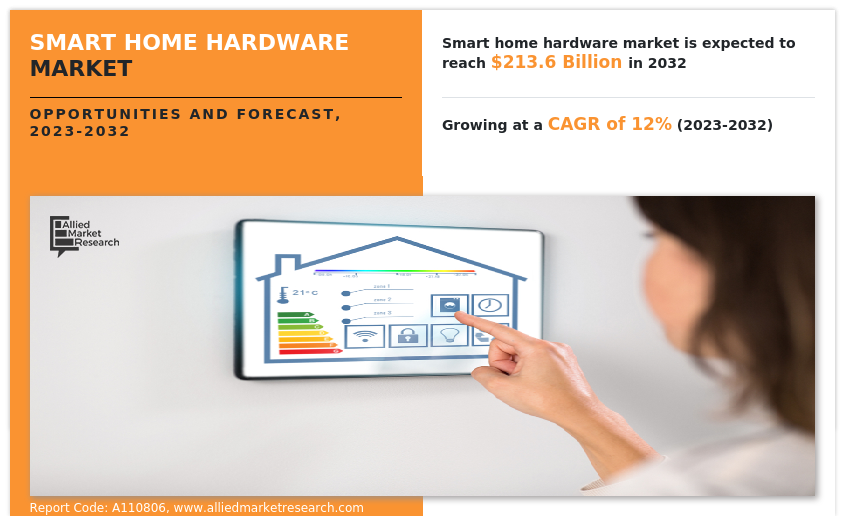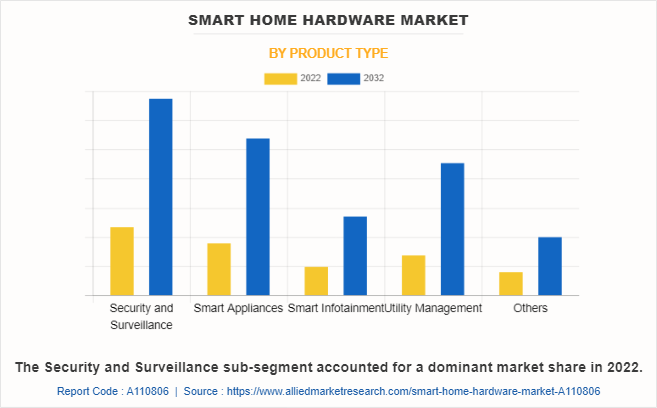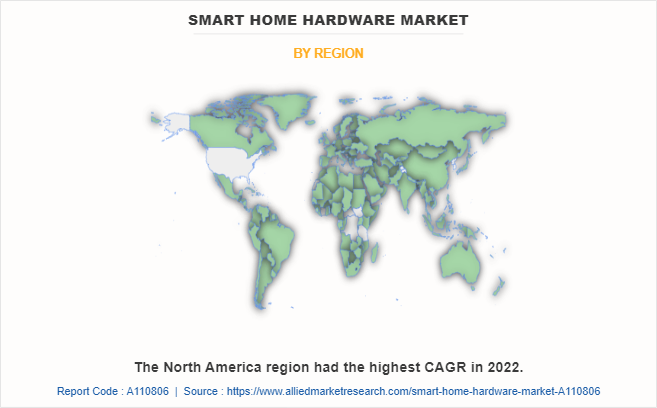Smart Home Hardware Market Research, 2032
The Global Smart Home Hardware Market size was valued at $72.4 billion in 2022, and is projected to reach $213.6 billion by 2032, growing at a CAGR of 12% from 2023 to 2032.
Smart home hardware refers to the devices that serve as a central processing unit of a smart home. It is a smart device that can communicate with other devices, connect to smart home systems and take desired actions. The hardware for smart homes is connected to the Internet and stores information on the cloud. Smart home devices include speakers, doorbells, alarm systems, televisions, bluetooth deadbolt locks, and other equipment.
Smart home appliances are suitable for a house configuration where appliances may be controlled remotely using a mobile or another networked device from any Internet-connected location. Features like security access, lighting, temperature, and entertainment appliances can all be controlled by the consumer.
The digital revolution has transformed practically every area of individuals' lives, including how they live, with gadgets that make houses smarter. As people continue to integrate technology into every aspect of their lives, the idea of having a home that directly interacts with its occupants no longer seems as far-fetched as it was a decade ago.. The global smart home hardware market is predicted to grow due to increase in disposable income and rise in demand for high-end energy-consuming products.
The rising need for smart sensors, switches, and relays, among other smart devices, is accelerating the adoption of advanced technologies such as Artificial Intelligence (AI) and Near-field communication (NFC). Emerging smart city initiatives all around the world are also driving the growth of the smart home hardware business. The primary drivers of the smart home hardware market include increased purchasing power, increased investment in infrastructure construction, technological advancements, and government backing.
However, there are a few major constraints impacting the smart home hardware market share. The primary challenge is the higher cost of integrating cutting-edge technology at the home. The inclusion of wireless cameras, light sensors, central touch displays, and automated systems raises the property's worth dramatically, putting it out of reach for some potential buyers.
The cost of incorporating smart home automation hardware tends to be more expensive as it is relatively new concept. The cost of purchasing and installing the necessary hardware can be significant, especially for those on a tight budget or looking to remodel an existing home. This affordability barrier is projected to limit the widespread adoption of smart home hardware market growth.
The smart home hardware industry is becoming more automated and digitalized. The various startups involved in smart home automation technology are exploring new solutions to provide homeowners with the best home experience while maintaining safety. Some important smart home hardware trends include smart home connectivity, smart home security, and next-generation entertainment. Many smart home users use robotics to automate monotonous tasks in their daily lives. For instance, many startups are developing new intelligent home control and operating systems that will establish communication between smart home devices.
Wireless communication creates a network of in-home gadgets, transforming the ordinary house into a connected one. Smart home equipment that uses communication networking technologies automatically collaborates and serves as an environment that consists of a number of gadgets and devices used in smart home hardware, which are connected via communication networking technologies, and work collectively in a coordinated manner to create an interconnected system. The various startups in the smart home hardware market are offering a variety of controlled solutions, such as wireless mesh networking, communication technologies, and wireless protocols. For instance, in March 2022, SPARK, a Canada-based firm, developed a high-bandwidth wireless technology with ultra-low power consumption and latency.
The capacity of smart home technology to work together as an ecosystem promotes highly demanded applications such as wireless virtual reality (VR) and the Internet of Things (IoT). These cutting-edge technologies are critical to the proper operation of smart homes. When combined with energy harvesting technologies used in smart homes, SPARKS' technology dramatically increases the battery life of gadgets and enables the battery-free functioning of wireless devices such as sensors. These factors are anticipated to boost the smart home hardware market opportunity.
The smart home hardware market forecast key players profiled in this report include Google LLC (Alphabet), Honeywell Corporation, Inc., Amazon.com Inc., Schneider Electric SE., Johnson Controls International plc, ABB Ltd., Legrand SA, Panasonic Corporation, Samsung Electronics Co Ltd, and General Electric. Investment and agreement are common strategies followed by major market players. For instance, in March 2023, NRG Energy, Inc. completed its acquisition of Vivint Smart Home, Inc., accelerating the realization of NRG's consumer-focused growth strategy and providing consumers with simple, connected experiences to intelligently power, protect, and manage their homes. The acquisition strengthens and diversifies NRG's financial profile while also broadening NRG's total market possibilities.
The smart home hardware market overview is segmented on the basis of product type and region. By product type, the market is divided into security & surveillance, smart appliances, smart infotainment, utility management, and others. By region, the market is analyzed across North America, Europe, Asia-Pacific, and LAMEA.

By product type, the security & surveillance sub-segment dominated the market in 2022. Security & surveillance systems have become more sophisticated with the progress in intelligent home technology like intelligent doorbells, intelligent lighting, and surveillance cameras. For instance, intelligent doorbell devices not only notify homeowners when there is someone at their doorstep but also enable them to recognize and communicate with unknown individuals before granting entry. Moreover, intelligent surveillance cameras can be activated by motion and remotely accessed, enabling homeowners to supervise their properties in real time.
These systems also provide immediate alerts regarding any suspicious activity or unauthorized efforts to access entrances or windows. Another benefit of intelligent security systems is their ability to continue monitoring and issuing alarms even when deactivated, unlike conventional home security systems. The advanced capabilities offered by these modern technologies simplify the task of homeowners managing and safeguarding their homes from a remote location, providing them with increased peace of mind while they are away from home. These are the major factors projected to drive the segment growth during the forecast period.

By region, North America dominated the global market in 2022. The primary factors driving the regional market growth include the strong technical infrastructure, rising disposable income, and rising consumer awareness of smart home technologies. With an increasing number of houses utilizing connected gadgets and automated systems, North America leads the way in smart home adoption. A diverse range of smart home hardware devices, such as smart lighting solutions, sensors, security monitoring systems, entertainment gadgets, and smart appliances.
The increasing desire for convenience, energy efficiency, and security is one of the reasons driving the regional market expansion. Smart home gadgets enable homeowners to remotely monitor and manage various parts of their houses for more convenience. This factor is driving the adoption of smart home hardware industry in the region.
Impact of COVID-19 on the Global Smart Home Hardware Industry
- The COVID-19 pandemic disrupted global supply chains, leading to delays in manufacturing, shortages of components, and logistical challenges. These disruptions have affected the production and availability of smart home hardware, leading to supply constraints and increased prices.
- The economic impact of the pandemic has resulted in financial constraints for many consumers. High unemployment rates and reduced disposable income have made it challenging for some individuals to invest in smart home hardware, resulting in a potential decline in sales.
- Smart home devices often require professional installation or technical expertise. During the pandemic, restrictions on home visits and concerns about personal contact have made it difficult for installation services to operate smoothly, delaying deployments and installations.
- The widespread shift to remote work has increased the importance of having a dedicated home office or workspace in the post-pandemic period. Smart home hardware, including smart lighting, energy management systems, and video conferencing equipment, can enhance productivity, comfort, and efficiency in home office setups.
Key Benefits For Stakeholders
- This report provides a quantitative analysis of the market segments, current trends, estimations, and dynamics of the smart home hardware market analysis from 2022 to 2032 to identify the prevailing smart home hardware market opportunities.
- The market research is offered along with information related to key drivers, restraints, and opportunities.
- Porter's five forces analysis highlights the potency of buyers and suppliers to enable stakeholders make profit-oriented business decisions and strengthen their supplier-buyer network.
- In-depth analysis of the smart home hardware market segmentation assists to determine the prevailing market opportunities.
- Major countries in each region are mapped according to their revenue contribution to the global market.
- Market player positioning facilitates benchmarking and provides a clear understanding of the present position of the market players.
- The report includes the analysis of the regional as well as global smart home hardware market trends, key players, market segments, application areas, and market growth strategies.
Smart Home Hardware Market Report Highlights
| Aspects | Details |
| Market Size By 2032 | USD 213.6 billion |
| Growth Rate | CAGR of 12% |
| Forecast period | 2022 - 2032 |
| Report Pages | 290 |
| By Product Type |
|
| By Region |
|
| Key Market Players | ABB Ltd., Johnson Controls International plc, Samsung Electronics Co Ltd, Legrand SA, Panasonic Corporation, Google LLC (Alphabet), Amazon.com Inc., General Electric, Schneider Electric SE., HONEYWELL CORPORATION, INC. |
Smart home hardware is expected to expand into health & wellness applications, such as remote health monitoring, ambient-assisted living, and personalized healthcare, which is expected to drive the market growth. Smart home devices can track vital signs, provide medication reminders, and create ambient environments to support well-being and aging-in-place, which is predicted to create opportunities.
The major growth strategies adopted by smart home hardware market players are investment and agreement.
Asia-Pacific is projected to provide more business opportunities for the global smart home hardware market in the future.
Google LLC (Alphabet), Honeywell Corporation, Inc., Amazon.com Inc., Schneider Electric SE., Johnson Controls International plc, ABB Ltd., Legrand SA, Panasonic Corporation, Samsung Electronics Co Ltd, and General Electric are the major players in the smart home hardware market.
The security & surveillance sub-segment of product type acquired the maximum share of the global smart home hardware market in 2022.
Luxury apartments, homes, hotels, resorts, and others are the major customers in the global smart home hardware market.
The report provides an extensive qualitative and quantitative analysis of the current trends and future estimations of the global smart home hardware market from 2022 to 2032 to determine the prevailing opportunities.
Retrofitting existing homes with smart home hardware is the trend projected to influence the smart home hardware market in the upcoming years.
Loading Table Of Content...
Loading Research Methodology...



